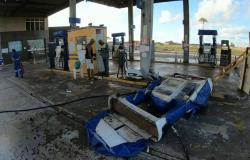From June 2020 until the third outbreak, life in Taiwan was pre-pandemic, except for the mandatory mask and temperature checks in the public transportation introduced on March 31st, 2020 and at large events9. Large events with tens of thousands of visitors were held, such as the Mayday New Year’s Eve pop concert at Taoyuan International Baseball Stadium on December 31st, 202010. Both the 2nd and 3rd outbreaks involved the Alpha variant (B.1.1.7), which Hsu et al.11 estimated to have a 1.44-fold higher infection probability and 57% higher basic reproduction number based on household transmissions during the 1st and 2nd outbreak, in agreement with previous estimates of 43–90%12. Evidently, the measures in place to reduce transmissibility and prevent a large-scale outbreak were not sufficient, so Taiwan should have had an outbreak in cases of community transmission existed during the two periods without local infections. In addition, the National Health Insurance Administration (NHIA) was proactively seeking out patients with severe respiratory symptoms in its database and allowing all hospitals, clinics, and pharmacies to see the patients’ travel history obtained from the National Immigration Agency from February 18th, 2020 onwards13. The third outbreak has been traced to a cluster of infected China Airline pilots and the Novotel at Taoyuan International Airport violating the quarantine rules by housing quarantined flight crews and local guests in the same building14.15. This initial failure of the mandatory quarantine at the border and contact tracing during the third outbreak combined with the success of contact tracing during the 2nd and 3rd outbreaks and the transmissibility reduction measures remaining the same, implies that Taiwan’s success was due to border control and tracing of contacts upon suspicion. Thus we can with confidence say that Taiwan has ended the three community outbreaks thanks to contact tracing, testing, and isolation. This leads us to the conclusion that Taiwan serves as an exemplary case, implementing a near ideal non-pharmaceutical intervention (NPI).
The Taiwanese COVID-19 control strategy implemented by the Central Epidemic Command Center (CECC), activated on January 20th, 202013, is based on six main pillars: (a) border control with quarantine upon arrival, (b) self-health monitoring when having visited a place with known cases, (c) testing when showing symptoms and seeking medical care, (d) mandatory supervised quarantine of confirmed infected and individuals at high risk of having been infected, (e) contact tracing, and (f) a four-level system of measures to suppress community spread. These are devised to control the effective reproduction number, ie the expected number of people an infected individual will transmit the disease to while infectious. The number can be seen as the transmission reproduction risk per contact (transmissibility), times the number of contacts per day, and times the number of days the person is infectious. From June 7th until May 11th, 2020, no restrictions on the size of gatherings, ie curbing of the number of contacts, existed15.16. Taiwan had a system with four levels of non-pharmacological interventions (NPIs). The level 3 measures in place from May 19th, 2021 until July 27th, 2021 consist of mandatory wearing of masks at all times outside private spaces and social distancing, which reduces the transmissibility; indoor gatherings limited to five people and closure of certain businesses, partly including schools and preschools, which reduce the number of contacts; and mandatory COVID-19 testing in areas where community transmission has taken place, which reduces the number of days an infected person can transmit the disease before being quarantined17,18,19. As demonstrated by numerous countries, such as the United Kingdom and United States, community suppression measures, such as lockdowns, alone do not end a community outbreak.
The key to ending an outbreak is to focus on contact tracing to bring up the number of suspects and increase testing and isolation/care capacity. The focus on contact tracing and bringing up the number of suspects is key because one needs to prevent every infected person from infecting a new person to end the outbreak. It makes the ratio of confirmed infected to suspected the essential metric to follow. The Lancet Commission Task Force on public health measures to suppress the pandemic also report on the effectiveness of contact tracing and quarantine measures, albeit not on their use to end outbreaks20. Since May 19th, 2021, Taiwan has implemented an SMS text message contact tracing system based on each person upon entry in each business scanning a place specific QR code that generates a unique SMS sent to 1922–the Taiwan Center for Disease Control hotline, which helps scale the contact tracing21.
Using the exponential model to fit the 7-day average of local & unknown confirmed to suspected cases, we obtained a forecast that differed by only 11 days from the real observation crossing the threshold, showing that our method can predict the end date of a community outbreak when the policy remains unchanged. Taiwan ended the three community outbreaks thanks to contact tracing, testing, and isolation. In addition to forecasting outbreak endpoints, we posit that our model can serve as a metric for assessing the alignment of an outbreak with the projected trend, indicative of effective adherence to an ideal Non-Pharmaceutical Intervention (NPI). We specifically emphasize its utility as a metric for gauging the effectiveness of contact tracing-observing that an increase in the number of suspected cases relative to confirmed cases is crucial for ending an outbreak. As illustrated in supplementary Fig. 4, our model predicts that the outbreak will continue indefinitely until the contact tracing has been scaled up so the number of suspected cases enables capture of infected cases. The dual functionality of our model positions it as a valuable tool for governments, also aiding in the discernment of the optimal timing for easing stringent NPI measures, such as lockdowns.
After this report on how Taiwan ended three outbreaks, we hope the world would take notice and learn from the Taiwanese strategy, so unnecessary suffering and deaths can be avoided in future pandemics. Like Wang et al.13we think “Taiwan is an example of how a society can respond quickly to a crisis and protect the interests of its citizens.”





